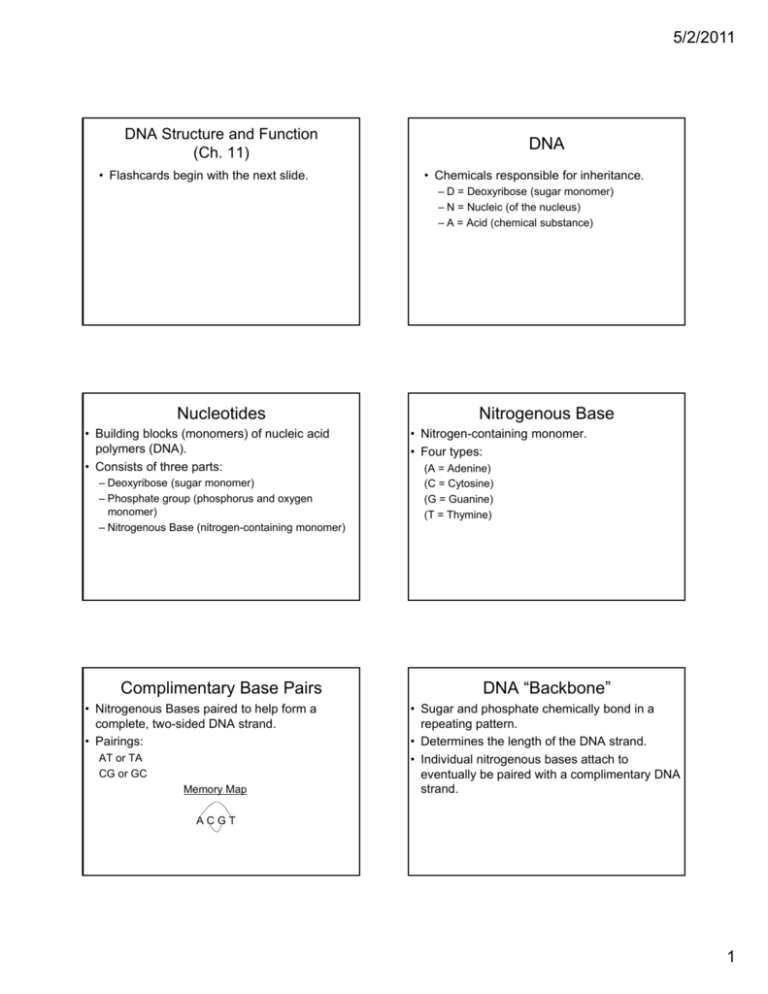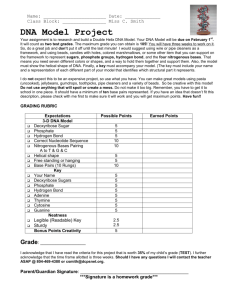DNA Nucleotides Nitrogenous Base Complimentary Base Pairs
advertisement

5/2/2011 DNA Structure and Function (Ch. 11) • Flashcards begin with the next slide. DNA • Chemicals responsible for inheritance. – D = Deoxyribose (sugar monomer) – N = Nucleic (of the nucleus) – A = Acid (chemical substance) Nucleotides • Building blocks (monomers) of nucleic acid polymers (DNA). • Consists of three parts: – Deoxyribose (sugar monomer) – Phosphate group (phosphorus and oxygen monomer) – Nitrogenous Base (nitrogen-containing monomer) Complimentary Base Pairs • Nitrogenous Bases paired to help form a complete, two-sided DNA strand. • Pairings: AT or TA CG or GC Memory Map Nitrogenous Base • Nitrogen-containing monomer. • Four types: (A = Adenine) (C = Cytosine) (G = Guanine) (T = Thymine) DNA “Backbone” • Sugar and phosphate chemically bond in a repeating pattern. • Determines the length of the DNA strand. • Individual nitrogenous bases attach to eventually be paired with a complimentary DNA strand. ACGT 1 5/2/2011 Double Helix • • Two strands of complimentary DNA twisted. If straightened would look like a ladder. – Outer edges of the ladder is the backbone of sugars and phosphates – “Rungs,” or steps of the ladder are the complimentary nitrogenous base pairs (AT or CG). • DNA Replication • • • The double helix is the “final draft,” of an organism’s DNA which determines characteristics and functions within the body. DNA Replication (The Process) • Enzymes (types of proteins) make it happen: RNA • 1. Double helix separates. 2. New individual nucleotides are formed: – Gathering and organizing individuals atoms of elements like nitrogen and carbon that enter an organisms body, cells and then the nucleus (where DNA is stored). 3. Individual nucleotides are bonded together to form the appropriate backbone and nitrogenous base arrangement. 4. New arrangements formed should be the compliment DNA strands that match with each separated strand of the original double helix of DNA. 5. Original DNA is now “Replicated.” This is what happens in the S-Phase of Interphase within the Cell Cycle. • The chemicals in the body responsible for most of the day-to-day functions of the body. Polymers built from amino acid monomers. – An amino acid is made from a combination of three nitrogenous bases in a group. – Where do nitrogenous base combinations come from? • • DNA!!!!!!!!!!!!!!!!!!!!!!! Examples: Ribonucleic acid (Alternative version of DNA) – Ribose = sugar different from deoxyribose. – Nucleic acid = chemical of the nucleus. • • Analogy: RNA is to DNA as Weis Brand Cola is to Pepsi. Job: Take information from the DNA to the cytoplasm and organelles that are outside of the nucleus. – Organelles now have instructions to perform functions necessary for the life of the organism. Proteins • Replicate: Reproduce exactly Process of copying the DNA molecule. Each strand of a double helix is replicated (reproduced). Transcription • • • Prefix “Tran” means: over, across, beyond. Scribe means: written Transcription: DNA chemical arrangement (instructions for body) is rewritten in the form of RNA. – This version of information chemically similar to DNA. – Now in a usable arrangement to form proteins for body functions. – Enzymes to cause chemical reactions in body. – Structures like hair and muscle. 2 5/2/2011 Translation • Translate: Change form or verify meaning in another form. – RNA contains rewritten DNA instructions that are now usable to make proteins. – Enzymes allow for translation of RNA instructions. – Translation of RNA results in the formation of proteins necessary for many body functions. – Cell organelles that are outside of the nucleus use these translated chemical instructions to perform their function necessary for the body. 3






